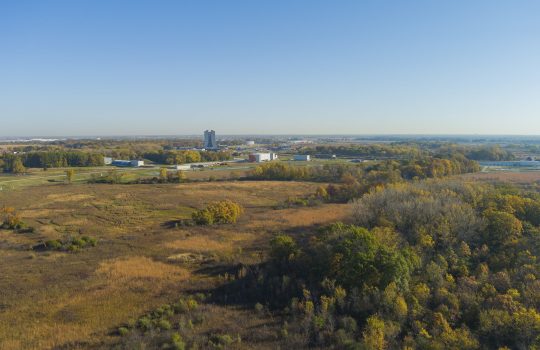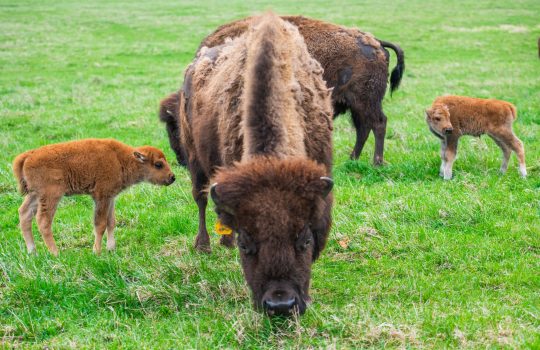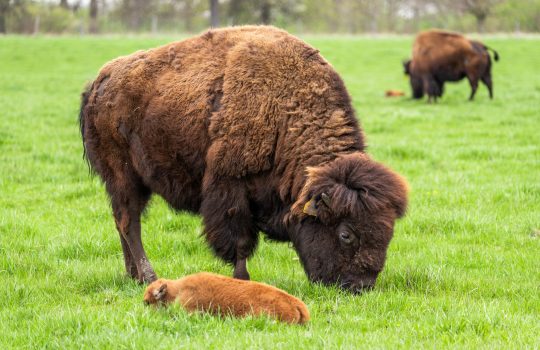Chicagoland has been a stronghold for birds for the past two decades, a recent report showed, and the U.S. Department of Energy’s Fermi National Accelerator Laboratory plays a key role in providing habitat for birds.
The Bird Conservation Network, a group of 21 Chicago-area nature conservation organizations, presented the results of the last 22 years of bird population monitoring during colloquium at Fermilab on July 12. Alongside BCN’s own bird counts, the group presented the data gathered at Fermilab since 1987.
“Fermilab has been preserving and restoring thousands of acres of land, and our findings show that efforts like those are having an incredible impact on birds in the Chicagoland region,” said BCN President Eric Secker. “By managing preserved habitats and prioritizing ecologically sensitive areas, Fermilab has protected threatened species and shown the surrounding community how development and growth can take place in a way that allows birds and natural areas to continue to thrive.”
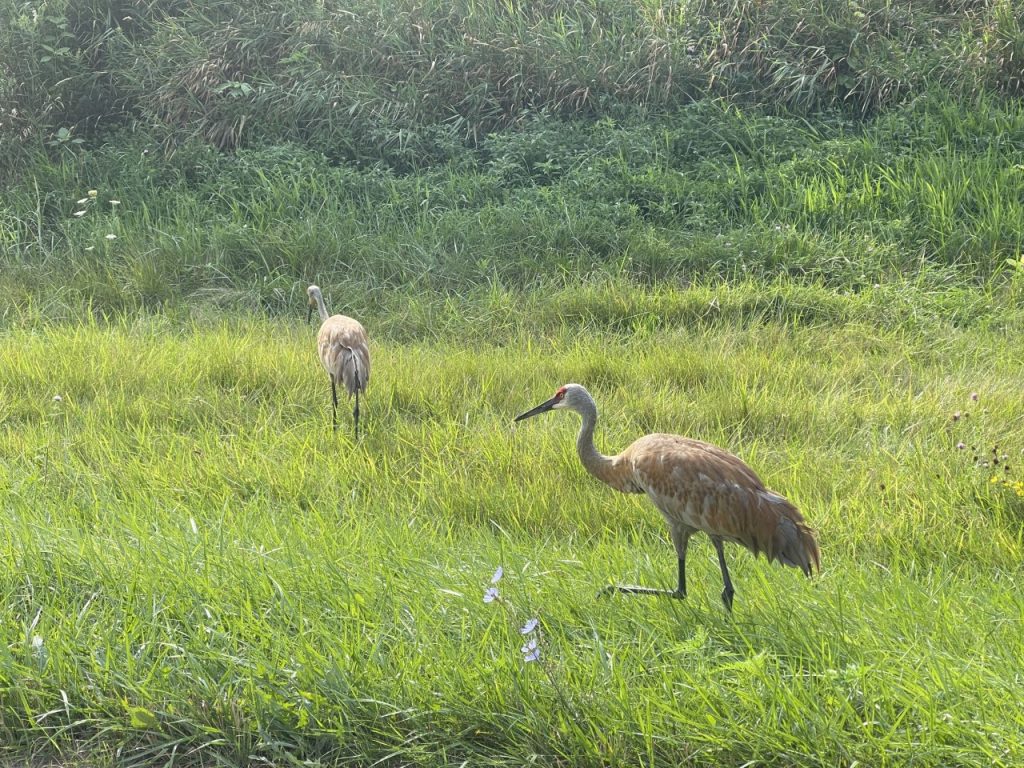
Sandhill cranes, a species that has become more common in the Chicago area, walk among the tall grasses on Discovery Road. Photo: Rude Perez, Fermilab
Much of BCN’s report brought good news about local bird populations. In the Chicago area, 56% of bird species are either stable or increasing, compared to 37% elsewhere in the state. The sandhill crane, a bird that lives near marshes and ponds, has increased in the Chicago area 7.3% annually according to the BCN report, and the Fermilab data shows that sandhill cranes have been seen more consistently, especially since 2012.
Not all bird species are doing well, however. The black-crowned night-heron, for example, has declined 10.5% annually, and its presence at Fermilab became less common in the 2017-to-2021 reporting period.
Bird monitoring and land management has been a part of Fermilab for decades. Prairie restoration efforts at Fermilab began in 1975, pioneered by local biologist Robert Betz. Fermilab has a long history of supporting science-based long history as part of its mission: Founding director Robert Wilson immediately championed the idea when Betz proposed a prairie restoration project. The conservation work over the decades has resulted in about 1,000 acres of restored prairie.
Peter Kasper, a birdwatcher and retired Fermilab employee, began monitoring the birds at Fermilab in the mid-1980s. Eventually, he teamed up with a student from the Chicago Academy of Science who wanted to study the Fermilab birds, leading to a formal bird monitoring program. More than 290 species of birds have been identified on the Fermilab site since monitoring began.
“It’s interesting how it has evolved by individuals pushing for things like the prairie,” Kasper said. “It has been dedicated individuals who have kept that alive, myself included. The only reason we have all this data is because I like watching birds. Working at Fermilab was a golden opportunity for me to combine my physics interests with my birding interests.”
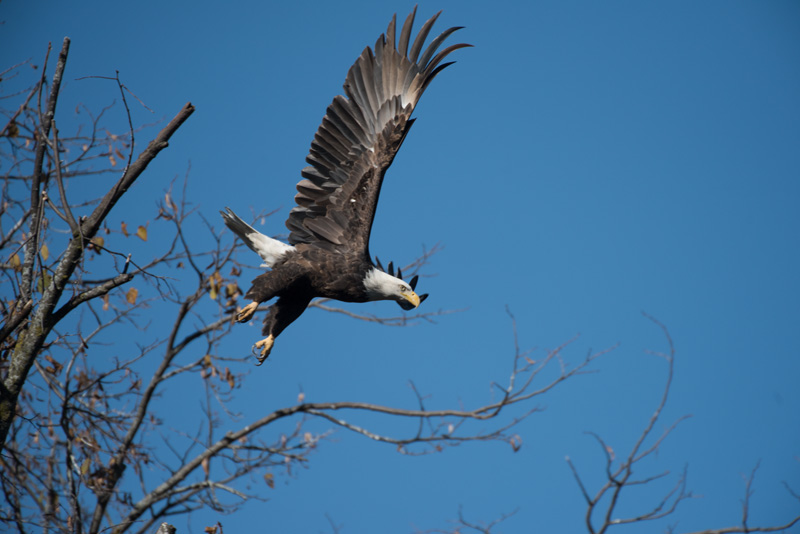
An American bald eagle takes off from a tree near Swan Lake at Fermilab. Photo: Reidar Hahn, Fermilab
Since then, Fermilab Natural Areas, a nonprofit organization that brings in volunteers to help manage the site’s 2,600 acres of natural area, continues to collect bird data and make the lab more hospitable for birds.
“The volunteer group gives people a way to interact with the natural areas to really feel ownership of them,” said Fermilab ecologist Wally Levernier. “If a steward is removing the last pieces of buckthorn in their woodland and restoring the understory, and they see how it started versus what it is now, it’s a huge sense of accomplishment.”
Although both the BCN survey and the Fermilab survey have lasted for decades, the two approaches provide different information about bird populations. BCN collects data twice per year during the breeding season and counts every bird that can be seen or heard. The Fermilab surveying program, in contrast, collects data every week of the year and only records whether or not a species is present. Since the Fermilab survey is year-round and weekly, it shows when migrating birds leave and come back throughout the year.
The Fermilab site was designated a National Environmental Research Park in 1989, one of only seven in the United States. It features many types of habitats typically found in Illinois, including grasslands, woodlands, wetlands, savannas, lakes and agricultural fields.
There are 12 spots throughout the Fermilab site where birds are monitored as part of BCN’s breeding bird survey, said Dave Spleha, who monitors birds for both Fermilab Natural Areas and BCN. When monitoring birds, Spleha walks to a particular point, waits a few minutes for birds to settle down after being disturbed, and begins counting the birds by either sight or sound within 75 meters for five minutes. Other bird monitoring throughout the year is less structured and takes place in random locations.
When gathering and analyzing bird population data, Spleha stresses the importance of species diversity.
“Diversity is one of the key factors,” he said. “If you have 20 breeding birds, and they’re all the same species, that’s good. But if you have 20 birds and there’s three different species, that’s better.”
The effort to make Fermilab’s natural areas more amenable to birds is ongoing. One such project to encourage the grasslands on Fermilab’s Eola Road involves comparing the use of prescribed fire on one side of the road and mowing the other side of the road to clear out larger plants. In the most recent experiment on Eola Road, relatively narrow strips of grass are mowed in different years to vary the height of the plants in each strip.
The Eola Road grassland is important for certain species, like the declining bobolink and Henslow’s sparrow, but brush and trees provide perches for hawks to hunt the grassland-nesting birds.
“Part of what we’re doing is researching what is most effective on site,” Levernier said. “Our site might be different from the next-door neighbor, but we can pass that information along and say what we’ve learned to help others along the way.”
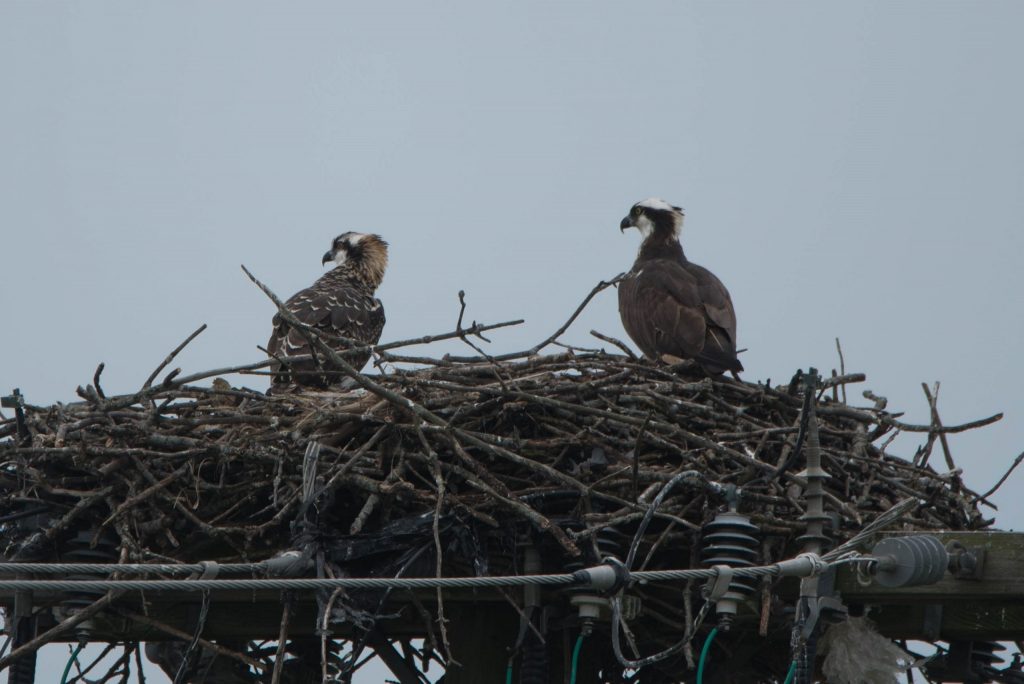
On July 15, 2020, an osprey chick (left) and an adult osprey (right) peer out onto the Fermilab campus from their nest. Photo: Wally Levernier, Fermilab
In contrast, when managing the shrubland on the east side of Fermilab, the team found that mowing hasn’t produced the proper vegetation structure for shrubland. Now, volunteers improve the shrubland by clearing all non-native plants by hand.
“That’s a time-intensive effort,” Levernier said. “We’re taking longer, but hopefully getting better habitat in the long run.”
The population of ospreys, a bird of prey, is one success story, with three nesting sites at Fermilab, Spleha said. Over the past 15 years, 73 ospreys have grown up at Fermilab; last year, there were nine young ospreys, the most ever in a year.
As weather patterns change and the suburbs of Chicago see more development, Spleha said providing a habitat for birds has become more crucial.
“Fermilab is right in the middle of a residential area,” he said. “If we don’t have a good, quality environment for these birds, there’s not going to be anything around here. This is just a little chunk, but it gives these birds a chance to breed in this area, and it keeps them one step away from extinction.”
By their nature, high-energy particle accelerators take up a lot of space while leaving plenty of open space for wildlife, Kasper said.
“It is a unique place, and it’s a model for how technology and wildlife need not be incompatible,” he said. “I think there’s something significant about the fact that you have one of the most advanced technological apparatuses in the same location as eagles and ospreys.”
Fermi National Accelerator Laboratory is supported by the Office of Science of the U.S. Department of Energy. The Office of Science is the single largest supporter of basic research in the physical sciences in the United States and is working to address some of the most pressing challenges of our time. For more information, please visit science.energy.gov.

